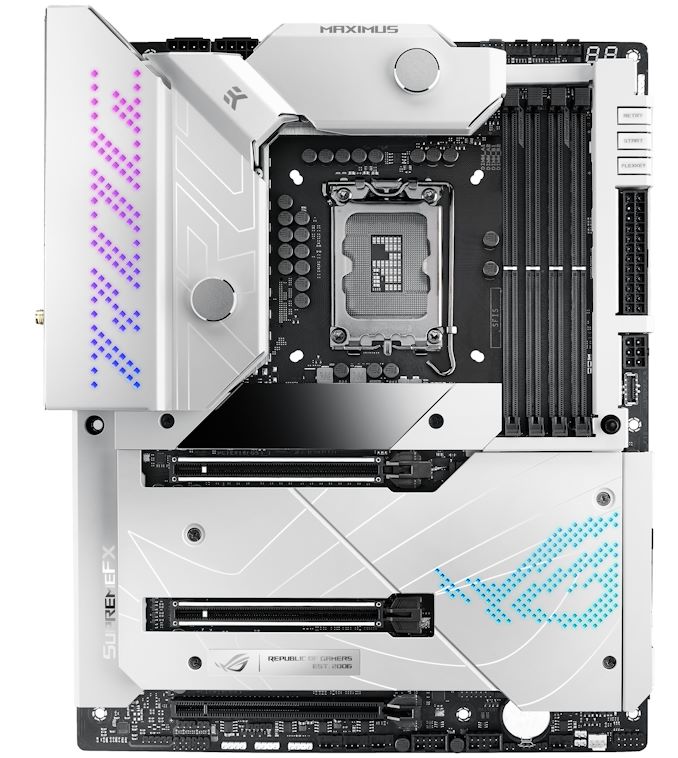The Intel Z690 Motherboard Overview (DDR5): Over 50+ New Models
by Gavin Bonshor on November 9, 2021 9:00 AM ESTASUS ROG Maximus Z690 Formula (DDR5)
Another mainstay of ASUS's ROG Maximus series returns for Z690, the ASUS ROG Maximus Z690 Formula. Fabled for its use of water-cooled VRMs, the latest Formula which ASUS actually skipped for Z590, is back for Z690 with a new aesthetic, including a new silver theme which is reminiscent of its Extreme Glacial models. The silver armor and heatsinks cover the majority of the PCB, with a custom milled EKWB heatsink cooling the power delivery, and allowing users to either passively cool them or hook them up to a custom water cooling kit for better VRM thermal performance. ASUS includes a fancy RGB-enabled ROG logo on the rear panel cover, with a similar design implemented into the chipset heatsink. ASUS is also advertising a large 20+1 teamed power delivery with premium 105 A smart power stages.
Dominating the lower portion of the board is plenty of PCIe and M.2 slots, including two full-length PCIe 5.0 slots operating at either x16 or x8/x8, with a third full-length PCIe 3.0 slot electronically locked down to x4. Touching more on M.2 support, the ASUS ROG Maximus Z690 Formula can accommodate up to five M.2 drives, including four with PCIe 5.0/4.0 x4 support, one with support for PCIe 3.0 x4 M.2 drives, and a total of six SATA ports with support for RAID 0, 1, 5, and 10 arrays. In the top right-hand corner are four memory slots with support for up to DDR5-6400, with a total capacity of 128 GB.
On the rear panel, ASUS includes two Thunderbolt 4 Type-C, one USB 3.2 G2 Type-C, six USB 3.2 G2 Type-A, and three USB 2.0 ports. There's a single HDMI video output for users looking to utilize the latest Intel integrated graphics, while five 3.5 mm audio jacks and S/PDIF optical output are controlled by a SupremeFX ALC4082 HD audio codec and ESS Sabre 9018Q2C amplifier pairing. Networking is very premium as expected, with one Marvel AQtion 10 GbE controller and an Intel-based Wi-Fi 6E CNVi offering both wireless and BT 5.2 device support. Lastly on the rear panel is a BIOS Flashback button and a clear CMOS button.











126 Comments
View All Comments
GeoffreyA - Saturday, November 13, 2021 - link
Certainly, there are tradeoffs, keeping a socket; but, as Mr. Tuvok would say, "Ryzen, you are an unending source of astonishment." There was a time when sockets even took CPUs from different manufacturers. I remember my Socket 7 motherboard, though I never tried it, could take a K5 and some Cyrix CPUs as well. Those 5x something, something. How things have changed.A short-lived socket can be a pain in the behind too. I was one of those unlucky folk who ended up with Socket 754 and missed out on dual-channel DDR and a long upgrade path. In any case, that computer went kaput after four years.
Oxford Guy - Wednesday, November 10, 2021 - link
Overclocking is for employees of motherboard companies.ECC RAM support should have been a standard feature from the beginning. Apple offered it on the Lisa in ‘83 and consumer computing has gone backward since.
Doublers, though... aren’t a bad thing as long as they’re implemented well — as I understand it. Better to have a good doubler implementation than a weak individual phase system. The main thing is to have a board meet the minimum spec for reliable (i.e. not overheating and/or failing) long-term support of its supported CPUs. Anything beyond that is unnecessary.
GeoffreyA - Saturday, November 13, 2021 - link
The problem with doublers is, they over-use it as a marketing technique to give the impression that a certain board has a large amount of phases.Oxford Guy - Saturday, November 13, 2021 - link
Weak phases with a mediocre/poor regulator aren’t necessarily better than ‘marketing phases’ via the use of doublers. That’s the case when the doublers are used a correctly.There are a lot of shenanigans, though — like not even utilizing the doubler fully but counting it as the doubling of phases. I also recall that one of the big tricks was putting extra chokes on the board to make it look like there are more phases.
GeoffreyA - Sunday, November 14, 2021 - link
Quite right, and one of the reasons why people have got to read a proper analysis of the VRM, or take a look at the lists on hardwareluxx for example.t.s - Tuesday, November 9, 2021 - link
Wish Intel go with their atv12vo. Or like business lines from HP, Dell, Lenovo, etc. 6 or 8 pin.shabby - Tuesday, November 9, 2021 - link
Mobo prices will go up even more, screw that.meacupla - Tuesday, November 9, 2021 - link
In the long term, I think the cost for ATX12VO will be cheaper.ATX12VO PSU will be cheaper than a comparable quality ATX PSU.
The BoM for 12V to 5V and 12V to 3.3V converters would go down, if mobo makers decide to stick to a single, standardized design.
With the way things are looking, electricity prices are unlikely to go down and continue to go up.
DigitalFreak - Tuesday, November 9, 2021 - link
All ATX12VO is doing is shifting the cost from the PSU to the motherboard.Wrs - Wednesday, November 10, 2021 - link
If mobo makers can stick to one design why can't PSU makers? They already conform to ATX.ATX 12 VO increases costs for piecemeal upgraders because of the simple observation that PSUs outlive motherboards. The question would be whether the power savings are worth it. For prebuilts they're comparing power savings to 0 net component cost so 12VO is already the norm.